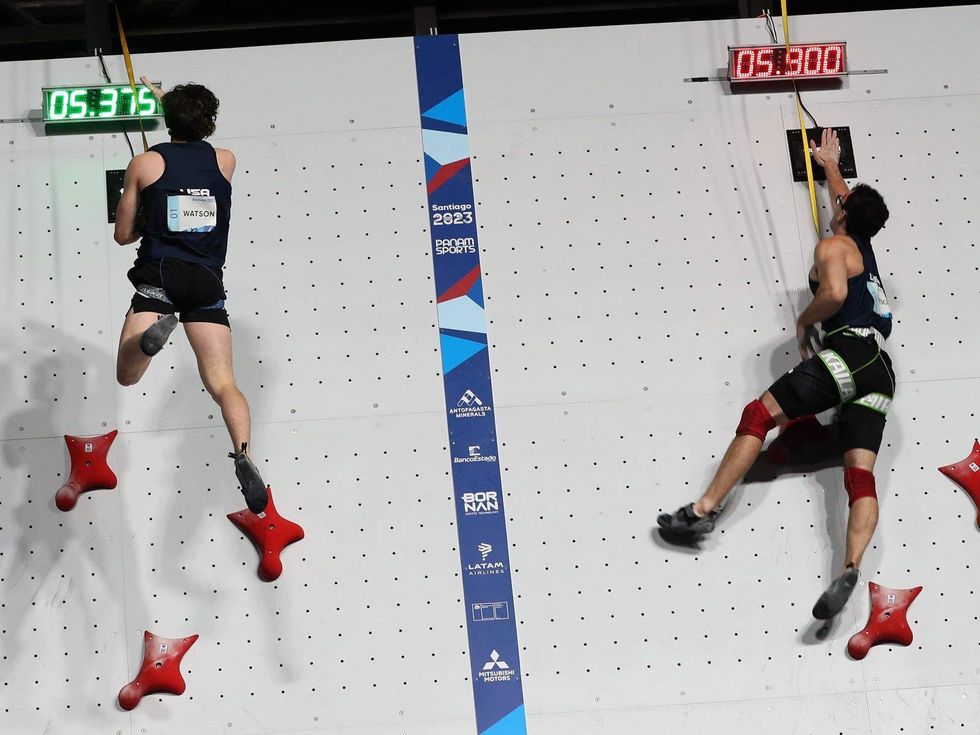It’s finally time to light the cauldron and let the 2024 Summer Olympic Games begin. The Games of the XXXIII Olympiad will run July 26-August 11 in Paris, and the Lone Star State has some of its biggest superstar athletes competing for Team USA.
In fact, of the nearly 600 American athletes on the team, more than 40 hail from Texas.
They include major headliners like Houston’s Simone Biles and Simone Manuel, Dallas’ Sha’Carri Richardson, San Antonio’s Fred Kerley, Austin's Gabby Thomas, along with the youngest member of Team USA, 16-year-old Plano gymnast Hezly Rivera, and a competitor in the all-new sport of breaking, Jeffrey "B-boy Jeffro" Louis of Houston.
There are as many ways to watch these hometown hopefuls as there are reasons to cheer them on. Here’s a basic primer on Olympic broadcast and streaming coverage from Paris (which is seven hours ahead of Texas):
- All coverage will be on NBC-owned channels, streaming services, and sites, including USA, E!, CNBC, The Golf Channel, and Telemundo.
- Every event will be streamed live via Peacock (PeacockTV.com/Olympics), as well as NBCOlympics.com, the NBC app, and the NBC Olympics app. Peacock makes it easy to search by sport, save events to “My Stuff,” and set reminders.
- NBC will carry at least nine hours of live event coverage starting each morning and continuing into the afternoon. Primetime in Paris will show competitions in the evening, and late-night coverage will continue after local news.
- Full event replays will be available on the NBCOlympics.com Replays hub.
- A guide at NBCOlympics.com schedule page can be filtered by sport, event, top athletes and topics like Must See, Team USA, Top Stars and Medal Events. There's also a toggle to show schedule info for "TV & Digital" or "TV Only."
- Find more information about special shows, hosts, and more here.
Below is a list of every Team USA athlete who calls Texas home, by birth or current residence — and at least one way to watch their qualifying events live. (Note that: 1. The list does not include every Texas college athlete or those representing other countries, 2. Information is as of press time; check listings for most up-to-date information, and 3. Yes, soccer and rugby really do start two days early, on July 24.)
Now, on your mark, get set, Go Team USA!
Women’s Artistic Gymnastics
Simone Biles, Spring
Events: Women’s Team Gymnastics
Watch: Women’s Team Qualification - July 28, 4:40 am on Peacock and E!; 6 pm on NBC
 Simone Biles practices on balance beam at Gymnastic Training Centre of Le Bourget on July 23.
Photo by David Ramos/Getty Images
Simone Biles practices on balance beam at Gymnastic Training Centre of Le Bourget on July 23.
Photo by David Ramos/Getty Images
Jordan Chiles, Conroe
Events: Women’s Team Gymnastics
Watch: Women’s Team Qualification - July 28, 4:40 am on Peacock and E!; 6 pm on NBC
Hezly Rivera, Plano
Events: Women’s Team Gymnastics
Watch: Women’s Team Qualification - July 28, 4:40 am on Peacock and E!; 6 pm on NBC
Men’s Artistic Gymnastics
Asher Hong, Plano/Tomball
Events: Men’s Team All-Around Gymnastics
Watch: Men’s Team Qualification - July 27, 4 am on Peacock and E!; 7 pm on NBC
Note: A complete schedule of Women’s and Men’s Gymnastics team and individual competitions can be found here.
Swimming
Simone Manuel, Sugar Land
Events: Women's 50m Freestyle
Watch: August 3 - 4 am on Peacock and USA
 Simone Manuel has been training with UT Austin's Bob Bowman.
Photo by Michael Reaves/Getty Images
Simone Manuel has been training with UT Austin's Bob Bowman.
Photo by Michael Reaves/Getty Images
Nic Fink, Dallas
Events: Men's 100m Breaststroke
Watch: July 27 - 4 am on USA and Peacock
David Johnston, Dallas
Events: Men's 1500m Freestyle, Men's 10km (open water)
Watch: August 3 - 4 am on Peacock and USA; August 9, 12:30 am on Peacock and USA
Matt King, Frisco
Events: Men’s 4x100 Freestyle Relay
Watch: July 27 - 4 am on Peacock and USA
Shaine Casas, McAllen
Events: Men's 200m Individual Medley
Watch: August 1 - 4 am on Peacock and USA
Diving
Alison Gibson, Austin
Events: Women's 3m Springboard
Watch: August 7 - 8 am on Peacock and E!
 Austin's Alison Gibson is one of the top divers in the world.Photo by Alex Slitz/Getty Images
Austin's Alison Gibson is one of the top divers in the world.Photo by Alex Slitz/Getty Images
Kassidy Cook, The Woodlands
Events: Women's Synch. 3m Springboard
Watch: July 27 - 4 am on Peacock and NBC
Breaking
Jeffrey Louis, Houston
Events: B-Boys
Watch: August 10 - 9 am on Peacock; 9:30 am on E!
 Jeffrey "B-boy Jeffro" Louis of Houston will compete in the first-ever Olympic Breaking event.Photo by Al Bello/Getty Images
Jeffrey "B-boy Jeffro" Louis of Houston will compete in the first-ever Olympic Breaking event.Photo by Al Bello/Getty Images
Track & Field
Gabby Thomas, Austin
Events: Women’s 200m
Watch: August 4 - 3 am on Peacock and USA
Sha’Carri Richardson, Dallas
Events: Women's 100m, Women's 4 x 100m Relay, Women's 200m
Watch: (100m heats) August 2 - 3 am on Peacock and E!, 9 am and 7 pm on NBC; (Relay heats) August 8 - 3 am on Peacock, 8 am on NBC; (200m heats) August 4 - 3 am on Peacock and USA
Alaysha Johnson, Spring
Events: Women's 100m Hurdles
Watch: August 7 - 3:15 am on Peacock and USA
Brynn King, The Woodlands
Events: Women's Pole Vault
Watch: August 5 - 3:40 am on Peacock
Bryce Deadmon, Houston
Events: 4 x 400m Relay Mixed
Watch: August 2 - 12:10 pm on Peacock and E!
Jacob Wooten, Tomball
Events: Men's Pole Vault
Watch: August 3 - 3:10 am on Peacock
 Pole vaulter Jacob Wooten is from Tomball and is a Texas A&M Aggie.Photo by Dean Mouhtaropoulos
Pole vaulter Jacob Wooten is from Tomball and is a Texas A&M Aggie.Photo by Dean Mouhtaropoulos
Joseph Brown, Mansfield
Events: Men's Discus Throw
Watch: August 5 - 3:10 am on Peacock
Jasmine Moore, Grand Prairie
Events: Women's Long Jump, Women's Triple Jump
Watch: (Long Jump heats) August 6 - 4:15 am on Peacock; (Triple Jump heats) August 2 - 11:15 am on Peacock
Jarrion Lawson, Texarkana
Events: Men's Long Jump
Watch: August 4 - 4 am on Peacock
Taliyah Brooks, Wichita Falls
Events: Women's Heptathlon
Watch: August 8 - 3 am on USA and Peacock
Bryce Hoppel, Midland
Events: Men's 800m
Watch: August 7 - 4:45 am on Peacock and USA; 8:20 am on NBC
Fred Kerley, San Antonio
Events: Men's 100m, Men's 4 x 100m Relay
Watch: (100m heats) August 3, 3:35 am on Peacock and E!; (4 x 100m Relay heats) August 8 - 4:35 am on Peacock and 8 am on NBC
Basketball
Brittney Griner, Houston
Events: Women’s Basketball (5x5)
Watch: July 29 - 2 pm on USA
 Brittney Griner returns to the Olympics as a new mom.
Photo by Christian Petersen Getty Images
Brittney Griner returns to the Olympics as a new mom.
Photo by Christian Petersen Getty Images
Hailey Van Lith, Fort Worth (TCU)
Events: Women’s Basketball (3x3)
Watch: July 30 - 10:30 am on Peacock and NBC
Cycling
Grant Koontz, Houston
Events: Men's Omnium
Watch: August 8 - 10 am on Peacock; August 9, 2:30 am on USA
Field Hockey
Kelsey Bing, Houston
Events: Women’s field hockey
Watch: July 27 - 12:45 on CNBC
Golf
Scottie Scheffler, Dallas
Events: Men's Individual Stroke Play
Watch: August 1 - 5 am on Golf Channel
 Scottie Scheffler is a favorite to bring home the gold in golf.
Photo courtesy of PGA Tour
Scottie Scheffler is a favorite to bring home the gold in golf.
Photo courtesy of PGA Tour
Rowing
Kaitlin Knifton, Austin
Events: Women's Four
Watch: July 28 - 2 am on Peacock
Teal Cohen, Dallas
Events: Women's Quadruple Sculls
Watch: July 27 - 2 pm on Peacock and USA
Sport Climbing
Sam Watson, Southlake
Events: Men's Speed
Watch: August 6 - 6 am on Peacock and USA
 Southlake speed climber Sam Watson completes his event in about five seconds.
Photo by Claudio Santana/Getty Images
Southlake speed climber Sam Watson completes his event in about five seconds.
Photo by Claudio Santana/Getty Images
Taekwondo
Jonathan Healy, Spring
Events: Men +80kg
Watch: August 7 - 2:30 am on Peacock
Volleyball
Avery Skinner, Katy
Events: Women's Team Volleyball
Watch: July 29 - 10 am on USA and 4 pm on NBC
Chiaka Ogbogu, Coppell
Events: Women's Team Volleyball
Watch: July 29 - 10 am on USA and 4 pm on NBC
Boxing
Joshua Edwards, Houston
Events: Men's +92kg
Watch: July 29 - 4 am on Peacock
Roscoe Hill, Spring
Events: Men’s 51kg
Watch: July 30 - 4 am on Peacock
Jennifer Lozano, Laredo
Events: Women's 50kg
Watch: July 28 - 4 am on Peacock
Rugby
Orrin Bizer, The Woodlands
Events: Men’s Team Rugby
Watch: July 24 - 8 am on Peacock; 10 am and 6 pm on USA
Kevon Williams, Houston
Events: Men’s Team Rugby
Watch: July 24 - 8 am on Peacock; 10 am and 6 pm on USA
Tennis
Austin Krajicek, Allen
Events: Men's Doubles
Watch: July 27 - 5 am on Peacock
Shooting
Vincent Hancock, Argyle
Events: Skeet Men
Watch: August 3 - 8:30 am on Peacock and 10:45 am on CNBC
Ryann Phillips, Gail
Events: Trap Women
Watch: July 31 - 8:30 am on Peacock
Conner Prince, Burleson
Events: Skeet Men
Watch: August 3 - 8:30 am on Peacock and 10:45 am on CNBC
Austen Smith, Keller
Events: Skeet Women
Watch: August 4 - 8:30 am on Peacock and 1:30 pm on CNBC
Keith Sanderson, San Antonio
Events: Men's 25m Rapid Fire Pistol
Watch: August 5 - 2:30 am on Peacock and 8:30 pm on USA
Soccer
Jaedyn Shaw, Frisco
Events: Women’s Soccer Team
Watch: July 25 - 2 pm on Peacock, 8 pm on USA
Weightlifting
Jourdan Delacruz, Wylie
Events: Women's 49kg
Watch: August 7 - 12:30 pm on Peacock


 Simone Biles practices on balance beam at Gymnastic Training Centre of Le Bourget on July 23.
Photo by David Ramos/Getty Images
Simone Biles practices on balance beam at Gymnastic Training Centre of Le Bourget on July 23.
Photo by David Ramos/Getty Images
 Simone Manuel has been training with UT Austin's Bob Bowman.
Photo by Michael Reaves/Getty Images
Simone Manuel has been training with UT Austin's Bob Bowman.
Photo by Michael Reaves/Getty Images
 Austin's Alison Gibson is one of the top divers in the world.Photo by Alex Slitz/Getty Images
Austin's Alison Gibson is one of the top divers in the world.Photo by Alex Slitz/Getty Images Jeffrey "B-boy Jeffro" Louis of Houston will compete in the first-ever Olympic Breaking event.Photo by Al Bello/Getty Images
Jeffrey "B-boy Jeffro" Louis of Houston will compete in the first-ever Olympic Breaking event.Photo by Al Bello/Getty Images Pole vaulter Jacob Wooten is from Tomball and is a Texas A&M Aggie.Photo by Dean Mouhtaropoulos
Pole vaulter Jacob Wooten is from Tomball and is a Texas A&M Aggie.Photo by Dean Mouhtaropoulos Brittney Griner returns to the Olympics as a new mom.
Photo by Christian Petersen Getty Images
Brittney Griner returns to the Olympics as a new mom.
Photo by Christian Petersen Getty Images
 Scottie Scheffler is a favorite to bring home the gold in golf.
Photo courtesy of PGA Tour
Scottie Scheffler is a favorite to bring home the gold in golf.
Photo courtesy of PGA Tour
 Southlake speed climber Sam Watson completes his event in about five seconds.
Photo by Claudio Santana/Getty Images
Southlake speed climber Sam Watson completes his event in about five seconds.
Photo by Claudio Santana/Getty Images